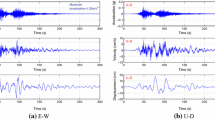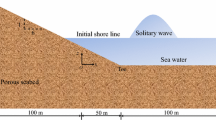Abstract
Wave-induced residual liquefaction in loose seabed floor brings great risk to the stability of offshore structures in extreme climates. Understanding the characteristics of wave-induced residual liquefaction due to pore pressure buildup in loose seabed is meaningful for engineers involved in the design of offshore structures. In this study, standing wave-induced residual liquefaction is investigated deeply and comprehensively adopting a validated integrated numerical model. The time history of standing wave-induced pore pressure, effective stress, shear stress, lateral pressure coefficient \(K_0,\) stress angle, and displacement of seabed surface are all quantitatively demonstrated. The variation process of progressive liquefaction, stress path, as well as the stress-strain relation also are illustrated in detail. It is shown that the integrated numerical model FSSI–CAS 2D (FSSI: fluid–structures–seabed interaction, CAS: Chinese Academy of Sciences) incorporating the PZIII soil model can effectively and precisely capture a series of nonlinear dynamic response characteristics of loose seabed floors under standing wave loading. The computational results further confirm that the wave-induced liquefaction in loose seabed soil is progressive downward, initiating at the seabed surface. In addition, it is found that two physical processes, including vertical distribution of oscillatory pore pressure and time history of stress angle possibly could be used to judge the occurrence of wave-induced residual liquefaction in loose seabeds. Furthermore, it is also found that the progressive liquefaction process is significantly affected by wave height, permeability and saturation of seabed soil.

















Similar content being viewed by others
References
Chan AHC (1988) A unified finite element solution to static and dynamic problems of geomechanics. PhD thesis, University of Wales, Swansea Wales
Cheng L, Sumer BM, Fredsoe J (2001) Solution of pore pressure build up due to progressive waves. Int J Numer Anal Method Geomech 25(9):885–907
Dunn SL, Vun PL, Chan AHC, Damgaard JS (2006) Numerical modeling of wave-induced liquefaction around pipelines. J Waterw Port Coast Ocean Eng 132(4):276–288
Hsu JR, Jeng DS (1994) Wave-induced soil response in an unsaturated anisotropic seabed of finite thickness. Int J Numer Anal Methods Geomech 18(11):785–807
Hsu TJ, Sakakiyama T, Liu PLF (2002) A numerical model for wave motions and turbulence flows in front of a composite breakwater. Coast Eng 46:25–50
Ishihara K (1993) Liquefaction and flow failure during earthquakes. Géotechnique 43(3):351–451
Jeng D-S (2003) Wave-induced sea floor dynamics. Appl Mech Rev 56(4):407–429
Jeng DS, Hsu JRC (1996) Wave-induced soil response in a nearly saturated seabed of finite thickness. Géotechnique 46(3):427–440
Jeng DS, Ou J (2010) 3d models for wave-induced pore pressures near breakwater heads. Acta Mech 215(1–4):85–104
Jeng DS, Zhao HY (2015) Two-dimensional model for accumulation of pore pressure in marine sediments. J Waterw Port Coast Ocean Eng 141(3). doi:10.1061/(ASCE)WW.1943-5460.0000282
Kammerer AM, Pestana JM, Seed RB (2002) Undrained response of monterey 0/30 sand under multidirectional cyclic simple shear loading conditions. Technical report, University of California, Berkeley. Geotechnical Engineering Research Report No. UCB/GT/02-01
Kirca V, Sumer B, Fredsoe J (2013) Residual liquefaction of seabed under standing waves. J Waterw Port Coast Ocean Eng 139(6):489–501
Lee TC, Tsai CP, Jeng DS (2002) Ocean wave propagating over a porous seabed of finite thickness. Ocean Eng 29:1577–1601
Li J, Jeng DS (2008) Response of a porous seabed around breakwater heads. Ocean Eng 35(8–9):864–886
Liao CC, Jeng DS, Zhang LL (2015) An analytical approximation for dynamic soil response of a porous seabed due to combined wave and current loading. J Coast Res 31(5):1120–1128
Liu B, Jeng DS (2016) Laboratory study for influence of clay content (cc) on wave-induced liquefaction in marine sediments. Mar Georesour Geotechnol. doi:10.1080/1064119X.2015.1005322
Liu Z, Jeng D-S, Chan AHC, Luan M (2009) Wave-induced progressive liquefaction in a poro-elastoplastic seabed: a two-layered model. Int J Numer Anal Methods Geomech 33(5):591–610
Lu HB (2005) The research on pore water pressure response to waves in sandy seabed. Master’s thesis, Changsha University of Science & Technology, Changsha, Hunan China
Lu X, Cui P (2004) The liquefaction and displacement of highly saturated sand under water pressure oscillation. Ocean Eng 31(7):795–811
Madsen OS (1978) Wave-induced pore pressure and effective stresses in a porous bed. Géotechnique 28(4):377–393
Miyamoto J, Sassa S, Sekiguchi H (2004) Progressive solidification of a liquefied sand layer during continued wave loading. Géotechnique 54(10):617–629
Mizutani N, Mostarfa A, Iwata K (1998) Nonliear regular wave, submerged breakwater and seabed dynamic interaction. Coast Eng 33:177–202
Mostafa A, Mizutani N, Iwata K (1999) Nonlinear wave, composite breakwater, and seabed dynamic interaction. J Waterw Port Coast Ocean Eng ASCE 25(2):88–97
Oka F, Yashima A, Shibata T, Kato M, Uzuoka R (1994) Fem-fdm coupled liquefaction analysis of a porous soil using an elasto-plastic model. Appl Sci Res 52(3):209–245
Ou J (2009) Three-dimensional numerical modelling of interaction between soil and pore fluid. PhD thesis, Universtity of Birmingham, Birmingham, UK
Pastor M, Chan AHC, Mira P, Manzanal D, Fernndez MJA, Blanc T (2011) Computational geomechanics: the heritage of Olek Zienkiewicz. Int J Numer Methods Eng 87(1–5):457–489
Pastor M, Zienkiewicz OC, Chan AHC (1990) Generalized plasticity and the modelling of soil behaviour. Int J Numer Anal Methods Geomech 14:151–190
Rahman MS, Jaber WY (1986) Simplified drained analysis for wave-induced liquefaction in ocean floor sands. Soils Found 26(3):57–68
Sassa S, Sekiguchi H (1999) Wave-induced liquefaction of beds of sand in a centrifuge. Géotechnique 49(5):621–638
Sassa S, Sekiguchi H, Miyamoto J (2001) Analysis of progressive liquefaction as a moving-boundary problem. Géotechnique 51(10):847–857
Sassa S, Takayama T, Mizutani M, Tsujio D (2006) Field observations of the build-up and dissipation of residual porewater pressures in seabed sands under the passage of stormwaves. J Coast Res 39:410–414
Seed HB, Martin PO, Lysmer J (1976) Pore-water pressure changes during soil liquefaction. J Geotech Eng ASCE 102(4):323–346
Seed HB, Rahman MS (1978) Wave-induced pore pressure in relation to ocean floor stability of cohesionless soils. Mar Geotechnol 3(2):123–150
Teh TC, Palmer AC, Damgaard JS (2003) Experimental study of marine pipelines on unstable and liquefied seabed. Coast Eng 50(1–2):1–17
Tsai CP, Lee TL (1995) Standing wave induced pore pressure in a porous seabed. Ocean Eng 22(6):505–517
Tsai CP, Lee TL, Hsu J (2000) Effects of wave nonlinearity on the standing wave-induced seabed response. Int J Numer Anal Method Geomech 24(11):869–892
Wang H, Liu HJ, Zhang MS (2014) Pore pressure response of seabed in standing waves and its mechanism. Coast Eng 91:213–219
Wu J, Kammaerer AM, Riemer MF, Seed RB, Pestana JM (2004) Laboratory study of liquefaction triggering criteria. In: Proceedings of 13th world conference on earthquake engineering, Vancouver, British Columbia, Canada. Paper No. 2580
Wu J, Seed RB, Pestana JM (2003) Liquefaction triggering and post liquefaction deformations of monterey 0/30 sand under uni-directional cyclic simple shear loading. Technical report, University of California, Berkeley. Geotechnical Engineering Research Report No. UCB/GE-2003/01
Xu H, Dong P (2011) A probabilistic analysis of random wave-induced liquefaction. Ocean Eng 38(7):860–867
Yamamoto T, Koning H, Sellmeijer H, Hijum EV (1978) On the response of a poro-elastic bed to water waves. J Fluid Mech 87(1):193–206
Ye JH (2012a) Numerical analysis of wave-seabed-breakwater interactions. PhD thesis, University of Dundee, Dundee, UK
Ye JH (2012b) Numerical modelling of consolidation of 2-D porous unsaturated seabed under a composite breakwater. Mechanika 18(4):373–379
Ye JH, Jeng D-S, Wang R, Zhu C-Q (2013) Validation of a 2D semi-coupled numerical model for fluid–structures–seabed Interaction. J Fluids Struct 42:333–357
Ye JH, Jeng D-S, Wang R, Zhu C-Q (2015) Numerical simulation of wave-induced dynamic response of poro-elasto-plastic seabed foundation and composite breakwater. Appl Math Model 39:322–347
Ye JH, Wang G (2015) Seismic dynamics of offshore breakwater on liquefiable seabed foundation. Soil Dyn Earthq Eng 76:86–99
Ye J, Wang G (2016) Numerical simulation of the seismic liquefaction mechanism in an offshore loosely deposited seabed. Bull Eng Geol Environ 75(3):1183–1197
Zhou XL, Wang JH, Xu B, Li YL (2013) An analytical solution for wave-induced seabed response in a multi-layered poroelastic seabed. Ocean Eng 38(1):119–129
Zienkiewicz OC, Chan AHC, Pastor M, Schrefler BA, Shiomi T (1999) Computational geomechanics with special reference to earthquake engineering. Wiley, New York
Zienkiewicz OC, Chang CT, Bettess P (1980) Drained, undrained, consolidating and dynamic behaviour assumptions in soils. Géotechnique 30(4):385–395
Zienkiewicz OC, Mroz Z (1984) Generalized plasticity formulation and applications to geomechanics. In: Desai CS, Gallagher RH (eds) Mechanics of engineering materials. Wiley, Chichester
Acknowledgements
Professor YE Jianhong is grateful for the funding support from the National Natural Science Foundation of China under project No. 41472291. Dr. Yang Guoxiang is thankful for the funding support from the National Natural Science Foundation of China under project No. 41302234.
Author information
Authors and Affiliations
Corresponding author
Rights and permissions
About this article
Cite this article
Yang, G., Ye, J. Nonlinear standing wave-induced liquefaction in loosely deposited seabed. Bull Eng Geol Environ 77, 205–223 (2018). https://doi.org/10.1007/s10064-017-1038-z
Received:
Accepted:
Published:
Issue Date:
DOI: https://doi.org/10.1007/s10064-017-1038-z




